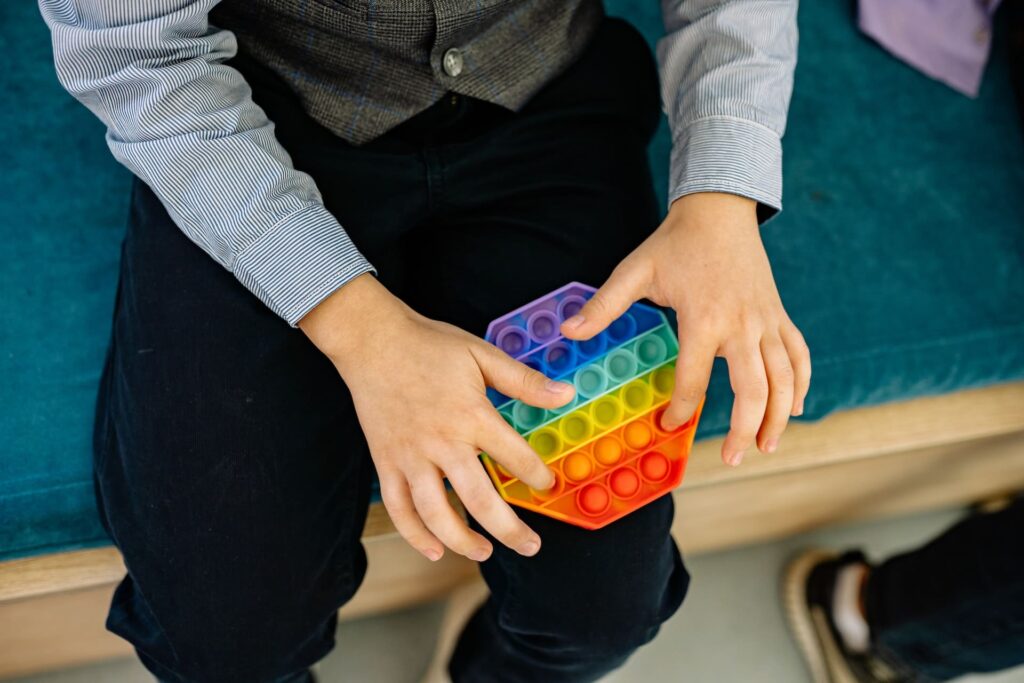A sensory seeking child typically craves experiences that engage their senses – tactile, visual, auditory, and more. Sensory seeking behavior is often a symptom of sensory processing disorder, and while it can coexist with ADHD, the two are not synonymous. Sensory seeking behavior can be managed using sensory toys that help meet their sensory needs, such as fidget toys, objects with different textures, or toys that involve deep pressure.
Autism and Sensory Toys
Children on the autism spectrum often have unique sensory needs and preferences. Toys for autistic children, often known as autism or stim toys, are specially designed to cater to these needs. They can range from bright lights to toys with different textures, calming sensory tools, or even fun toys that challenge their brain and imagination. Autism sensory toys not only provide sensory input but also offer a fun and engaging way to learn and develop essential skills.
Building a Sensory Tool Kit for Autism
For parents and educators, building a sensory tool kit for autism can be highly beneficial. This kit can include the child’s favorite sensory toys, sensory integration tools such as mini trampolines or balance balls, and other sensory solution products that help provide the required sensory input in a controlled and safe way. These tools serve as therapeutic aids to help manage sensory processing challenges and promote positive behaviors.
Sensory Toys for Overstimulated Children
Sensory toys are also highly beneficial for overstimulated children, providing calming and grounding effects. For instance, toys that require focused attention, such as a special kind of regular sand, can be a source of calm for children who are overwhelmed with sensory input.
Sensory Toys for Adults
Sensory tools are not limited to children. Adults, too, can significantly benefit from them. Sensory fidget toys for adults can assist in stress management, improve concentration, and provide calming effects. They can serve as excellent tools to help adults manage sensory processing or anxiety challenges. They can also provide a tactile distraction, allowing adults to focus their attention better.
Choosing Sensory Toys for Different Ages
Regardless of age, sensory toys are a fun and therapeutic way to help individuals manage sensory processing challenges, connect with their environment, and develop essential skills. Each sensory toy caters to specific sensory needs, making them ideal tools for both individuals with special needs and those who simply enjoy the unique sensory experiences these toys provide.
Final Words: Sensory Toys Beyond Just Play
Remember to always consult with a healthcare or educational professional when introducing new sensory tools or toys to a child or adult with a sensory processing disorder, autism, or any other special needs. This way, you can ensure that the chosen sensory toys will benefit the individual, help manage their sensory sensitivities, and contribute positively to their overall development.
Before purchasing any sensory toy, ensure that it is safe and appropriate for the child’s age and developmental level. You can usually find this information in the product’s details on the seller’s site. It’s also helpful to join autism or special needs communities where you can share experiences and get recommendations on the best sensory toys for your child’s needs.
In conclusion, sensory toys are more than just toys. They are tools that facilitate sensory processing, calm the senses, and promote the development of essential skills in children and adults alike. Whether it’s a child on the autism spectrum, a sensory seeking toddler, or an adult managing stress, sensory toys can truly be a game-changer.

